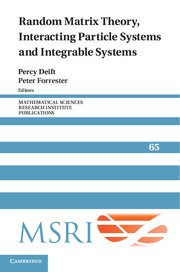Book contents
- Frontmatter
- Contents
- Preface
- Universality conjecture for all Airy, sine and Bessel kernels in the complex plane
- On a relationship between high rank cases and rank one cases of Hermitian random matrix models with external
- Riemann–Hilbert approach to the six-vertex model
- CLT for spectra of submatrices of Wigner random matrices, II: Stochastic evolution
- Critical asymptotic behavior for the Korteweg–de Vries equation and in random matrix theory
- On the asymptotics of a Toeplitz determinant with singularities
- Asymptotic analysis of the two-matrix model with a quartic potential
- Conservation laws of random matrix theory
- Asymptotics of spacing distributions 50 years later
- Applications of random matrix theory for sensor array imaging with measurement noise
- Convolution symmetries of integrable hierarchies, matrix models and τ-functions
- Universality limits via “old style” analysis
- Fluctuations and large deviations of some perturbed random matrices
- Three lectures on free probability
- Whittaker functions and relatedstochastic processes
- How long does it take to compute the eigenvalues of a random symmetric matrix?
- Exact solutions of the Kardar–Parisi–Zhang equation and weak universality for directed random polymers
- Replica analysis of the one-dimensional KPZ equation
- Asymptotic expansions for β matrix models and their applications to the universality conjecture
- KPZ scaling theory and the semidiscrete directed polymer model
- Experimental Realization Of Tracy–Widom Distributions And Beyond: Kpz Interfaces In Turbulent Liquid Crystal
- Random matrices: the four-moment theorem for Wigner ensembles
Exact solutions of the Kardar–Parisi–Zhang equation and weak universality for directed random polymers
Published online by Cambridge University Press: 29 May 2025
- Frontmatter
- Contents
- Preface
- Universality conjecture for all Airy, sine and Bessel kernels in the complex plane
- On a relationship between high rank cases and rank one cases of Hermitian random matrix models with external
- Riemann–Hilbert approach to the six-vertex model
- CLT for spectra of submatrices of Wigner random matrices, II: Stochastic evolution
- Critical asymptotic behavior for the Korteweg–de Vries equation and in random matrix theory
- On the asymptotics of a Toeplitz determinant with singularities
- Asymptotic analysis of the two-matrix model with a quartic potential
- Conservation laws of random matrix theory
- Asymptotics of spacing distributions 50 years later
- Applications of random matrix theory for sensor array imaging with measurement noise
- Convolution symmetries of integrable hierarchies, matrix models and τ-functions
- Universality limits via “old style” analysis
- Fluctuations and large deviations of some perturbed random matrices
- Three lectures on free probability
- Whittaker functions and relatedstochastic processes
- How long does it take to compute the eigenvalues of a random symmetric matrix?
- Exact solutions of the Kardar–Parisi–Zhang equation and weak universality for directed random polymers
- Replica analysis of the one-dimensional KPZ equation
- Asymptotic expansions for β matrix models and their applications to the universality conjecture
- KPZ scaling theory and the semidiscrete directed polymer model
- Experimental Realization Of Tracy–Widom Distributions And Beyond: Kpz Interfaces In Turbulent Liquid Crystal
- Random matrices: the four-moment theorem for Wigner ensembles
Summary
We survey recent results of convergence to random matrix distributions of directed random polymer free energy fluctuations in the intermediate disorder regime. These are obtained by passing through the exact formulas for fluctuations of KPZ at finite time.
1. Directed random polymers
Directed random polymers were introduced in the mid eighties as models of defect lines in media with impurities (see [Kardar 2007] for a review). They became popular in physics because besides their applicability as models and inherent interest, they are a case where the replica methods developed for the more difficult spin glass models give consistent answers. We will be interested in the 1 + 1 dimensional case. We are given a random environment ξ(i, j) of independent identically distributed real random variables for i, j in ℤ+ × ℤ. Given the environment, the energy of an n-step nearest neighbour walk x =(x1,..., xn is
The polymer measure on such walks starting at 0 at time 0 and ending at x at time n is then defined by
The parameter β > 0, which measures how much the path prefers to travel through areas of low energy, is called the inverse temperature. P is the uniform probability measure on such walks, and Z(n, x) is the partition function
This is the point-to-point free energy. If we do not specify the endpoint, we get the point-to-line free energy, which we denote by Zβ,ξ(n).
What happens is that for large n that path is localized about a path which is special for that n; it has lateral fluctuations of size n⅔. In terms of the free energy, the key conjecture is that its fluctuations are of size n⅓ and given by
Tracy–Widom distributions.
Information
- Type
- Chapter
- Information
- Publisher: Cambridge University PressPrint publication year: 2014
